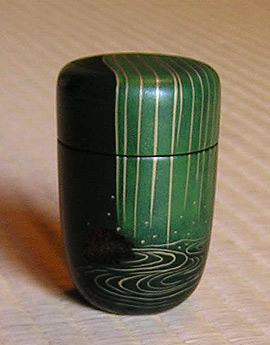|
||
 |
||

@
(C)2001 Japanese Architecture and Art Net Users System.@No reproduction or republication without written permission.
fΪΜeLXgEΚ^ECXgΘΗASΔΜRecΜ³f‘»E]ΪπΦΆά·B
|
||||||
| @ | ||||||
| natsume@₯ | ||||||
| KEY WORD :@architecture / tea houses | ||||||
| @ | ||||||
| A tea caddy for storing weak green powdered tea. Also called *usuchaki ν. The name natsume derived from the shape, which is similar to a Chinese date, natsume or jujube. The origin of this type of tea caddy is attributed to Haneda Gorou HcάY who lived near the Hokaimon @Eε at the temple Myoukakuji o in Kyoto, around the time of the rule of Ashikaga Yoshimasa «` (1433-90) in the Muromachi period, when the drinking of tea ceremonial was in its earliest stage. Natsume have various sizes and shapes: There are long, flat natsume, chamferred ones; styles favored by Sen Rikyuu ηx (1522-91), sen rikyuugata ηx` called kawatarou ΝΎY; shirifukurami Kc with large bottoms; the so-called tea-pail type, chaoke ±; those with a bulge in the middle doubari ·£; and those with a red top kouaka bΤ. The lid may be overlapping okibuta uW or in the styles of a medicine box inrou-zukuri σβΔ’. Natsume may be made of wood and dry lacquer *kanshitsu £½, bamboo, lacquer over layers of paper ikkanbari κΥ£, ceramic, metal, or even black quartz. Some natsume are coated with black wax kurorounuri Xh, some with a type of red lacquer, shutame ι, some with lacquer over various colors shunkei-nuri tch, or a rubbed lacquer coating, suriurushi ½. For decoration gold or silver powder was sometimes sprinkled over pear skin lacquer nashiji n, and sometimes oil paint was used. Carved lacquer horiurushi €½ lacquer and shell inlaid *raden ην was also used. | ||||||
| @ | ||||||
 |
||||||
@ |
||||||
| REFERENCES: | ||||||
| @ | ||||||
| EXTERNAL LINKS: | ||||||
| @@ | ||||||
| NOTES: | ||||||
| @ | ||||||
(C)2001 Japanese Architecture and Art Net Users System.@No reproduction or republication without written permission. fΪΜeLXgEΚ^ECXgΘΗASΔΜRecΜ³f‘»E]ΪπΦΆά·B |
||||||
| @ |